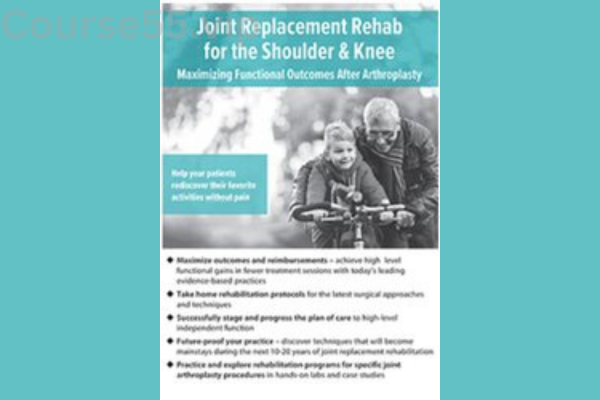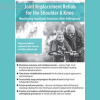Joint Replacement Rehab for the Shoulder and Knee: Maximizing Functional Outcomes After Arthroplasty By Terry Trundle – PESI
$99.00 Original price was: $99.00.$23.10Current price is: $23.10.
Joint Replacement Rehab for the Shoulder and Knee: Maximizing Functional Outcomes After Arthroplasty – Digital Download!

Joint Replacement Rehab for the Shoulder and Knee: Maximizing Functional Outcomes After Arthroplasty By Terry Trundle – PESI
Overview

Optimizing Rehabilitation for Shoulder and Knee Joint Replacements: Enhancing Functional Recovery Post-Arthroplasty
The field of orthopedic medicine continues to evolve, placing greater emphasis on rehabilitation strategies following shoulder and knee arthroplasty. The review “Joint Replacement Rehab for the Shoulder and Knee: Maximizing Functional Outcomes After Arthroplasty” by Terry Trundle, published by PESI, provides an in-depth analysis of effective rehabilitation techniques aimed at improving recovery and restoring function after joint replacement surgery. This article explores the critical elements of Trundle’s review, highlighting the importance of personalized rehabilitation programs, prehabilitation strategies, and the complexities of various recovery approaches.
The Role of Preoperative and Postoperative Guidelines
Trundle underscores the significance of both preoperative and postoperative rehabilitation guidelines in ensuring optimal recovery. Prehabilitation serves as a proactive method to enhance post-surgical outcomes by incorporating exercises that build strength, improve flexibility, and boost cardiovascular endurance prior to surgery. Research indicates that patients who engage in structured prehabilitation programs experience reduced postoperative pain, shorter hospital stays, and a faster return to daily activities.
Following surgery, rehabilitation protocols must be tailored to individual needs, rather than applying a universal approach. A personalized strategy that takes into account factors such as mobility limitations, pain levels, and individual weaknesses is essential for achieving the best possible outcomes, including improved movement, reduced discomfort, and enhanced functional capabilities.
Comparing Rehabilitation Approaches
Trundle’s review thoroughly examines the different rehabilitation models available, comparing self-guided and professionally supervised programs. Self-directed rehabilitation allows patients to manage their recovery independently using resources such as instructional videos and mobile applications. While this approach fosters autonomy and flexibility, its effectiveness varies based on patient engagement.
Conversely, supervised rehabilitation involves structured guidance from healthcare professionals, providing real-time feedback and adjustments to treatment plans. Studies indicate that patients in supervised programs achieve greater improvements in strength and mobility compared to those following a self-guided approach. A study in the Journal of Orthopedic Rehabilitation found that patients in supervised programs experienced a 30% increase in muscle strength and functional abilities within six weeks of surgery.
Comparison of Rehabilitation Methods
| Feature | Self-Directed Rehabilitation | Supervised Rehabilitation |
|---|---|---|
| Autonomy | High | Low |
| Professional Feedback | Limited | Continuous |
| Initial Cost | Lower | Higher (due to clinical oversight) |
| Strength Improvement | Moderate | Significant |
| Patient Satisfaction | Variable | Generally High |
Achieving the Best Functional Outcomes
A key objective of rehabilitation is to maximize functional recovery by addressing both physical and psychological aspects of the healing process. Trundle emphasizes that pain relief, improved mobility, and regaining independence in daily activities are crucial to a patient’s overall satisfaction.
Beyond physical recovery, mental and emotional well-being play a vital role in rehabilitation success. Patients who are well-informed and actively involved in their recovery tend to experience higher satisfaction levels. Effective communication between healthcare providers and patients is essential in setting realistic expectations and providing reassurance throughout the process. Additionally, ongoing assessments enable therapists to adjust treatment plans based on progress, ensuring a dynamic and responsive rehabilitation experience.
Implementing Evidence-Based Rehabilitation Strategies
The importance of evidence-based rehabilitation practices is a central theme in Trundle’s review. He highlights the effectiveness of graded exercise programs, which progressively increase in intensity to build strength, endurance, and joint flexibility. A randomized controlled study cited in the review found that patients following structured exercise regimens experienced notable reductions in pain and significant improvements in overall function compared to those who adhered to traditional, non-exercise-based rehabilitation methods.
Additionally, Trundle explores the benefits of manual therapy and neuromuscular re-education in post-arthroplasty recovery. These interventions enhance rehabilitation by combining exercises with functional training, pain management techniques, and psychological support, contributing to a more comprehensive treatment plan.
Addressing Common Rehabilitation Challenges
Despite the advancements in rehabilitation, patients often encounter barriers to recovery such as mobility limitations, persistent discomfort, and psychological distress. Trundle discusses strategies to overcome these obstacles, including gradual progression in exercise intensity to prevent reinjury while fostering patient confidence.
Motivation and social support are also critical factors in maintaining rehabilitation success. Encouragement from healthcare providers, along with structured check-ins, can help patients stay committed to their programs, reducing the likelihood of setbacks caused by frustration or fatigue.
Variability in Rehabilitation Protocols
A notable concern in post-surgical rehabilitation is the lack of standardization across healthcare systems. Trundle highlights how differences in clinical protocols—often influenced by resource availability—can result in inconsistent patient outcomes.
For rehabilitation programs to be effective, protocols should include a degree of standardization while allowing for flexibility based on individual needs. This balanced approach ensures that every patient receives high-quality, personalized rehabilitation care.
Comparison of Rehabilitation Protocols
| Factor | Standard Protocol | Tailored Approach |
|---|---|---|
| Flexibility | Low | High |
| Patient Individualization | Minimal | Significant |
| Recovery Tracking | Routine | Adaptive and Personalized |
| Outcome Measurement | General Metrics | Individual Progress Assessment |
Conclusion
Terry Trundle’s review serves as a comprehensive resource for medical professionals aiming to enhance rehabilitation outcomes following shoulder and knee arthroplasty. By highlighting the importance of preoperative preparation, contrasting different rehabilitation approaches, and advocating for evidence-based techniques, the review provides a structured guide to improving post-surgical recovery.
Addressing challenges such as patient motivation, standardization of rehabilitation protocols, and individualized treatment plans is crucial in achieving the best functional results. A personalized rehabilitation approach that adapts to each patient’s unique needs not only accelerates recovery but also improves overall quality of life, allowing patients to return to daily activities with confidence and reduced discomfort.
Frequently Asked Questions:
Business Model Innovation: We operate a group buying strategy, allowing participants to share costs and access popular courses at reduced prices. This model benefits individuals with limited financial resources, despite concerns from content creators about distribution methods.
Legal Considerations: The legality of our operations involves complex issues. Although we don’t have explicit permission from course creators to resell their content, there are no specific resale restrictions stated at the time of purchase. This ambiguity creates an opportunity for us to provide affordable educational resources.
Quality Control: We ensure that all course materials purchased are identical to those offered directly by the creators. However, it’s important to understand that we are not official providers. As such, our offerings do not include:
– Live coaching calls or sessions with the course author.
– Access to exclusive author-controlled groups or portals.
– Membership in private forums.
– Direct email support from the author or their team.
We aim to reduce the cost barrier in education by offering these courses independently, without the premium services available through official channels. We appreciate your understanding of our unique approach.
Be the first to review “Joint Replacement Rehab for the Shoulder and Knee: Maximizing Functional Outcomes After Arthroplasty By Terry Trundle – PESI” Cancel reply
You must be logged in to post a review.

 Advances in Motor Control and Learning for Neurological Rehab By Ben Sidaway - PESI
Advances in Motor Control and Learning for Neurological Rehab By Ben Sidaway - PESI 















Reviews
There are no reviews yet.